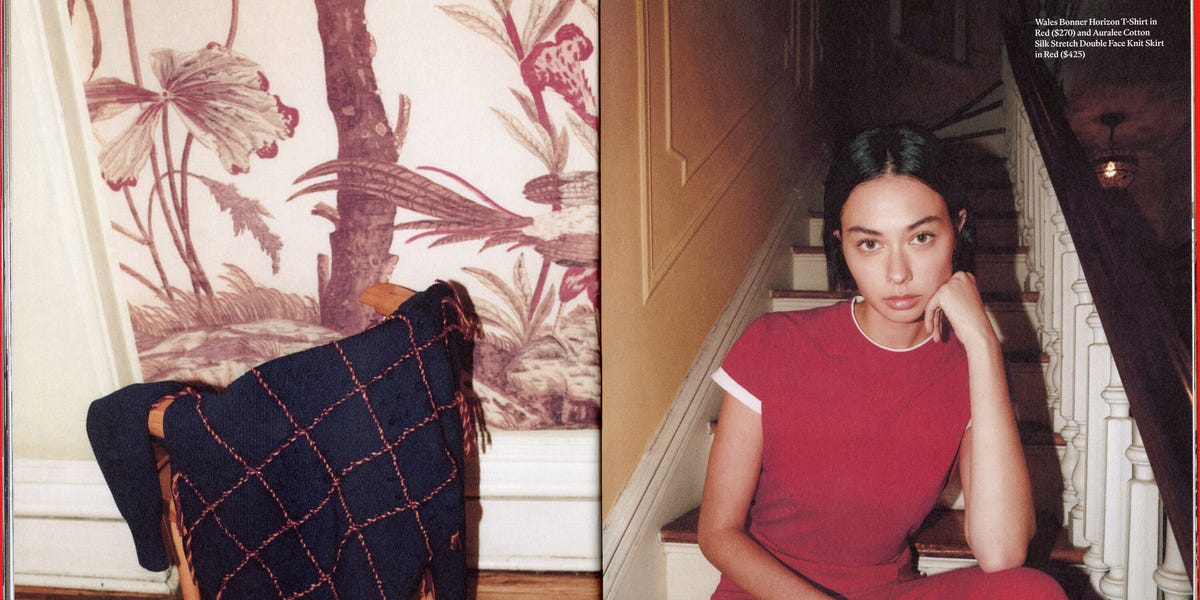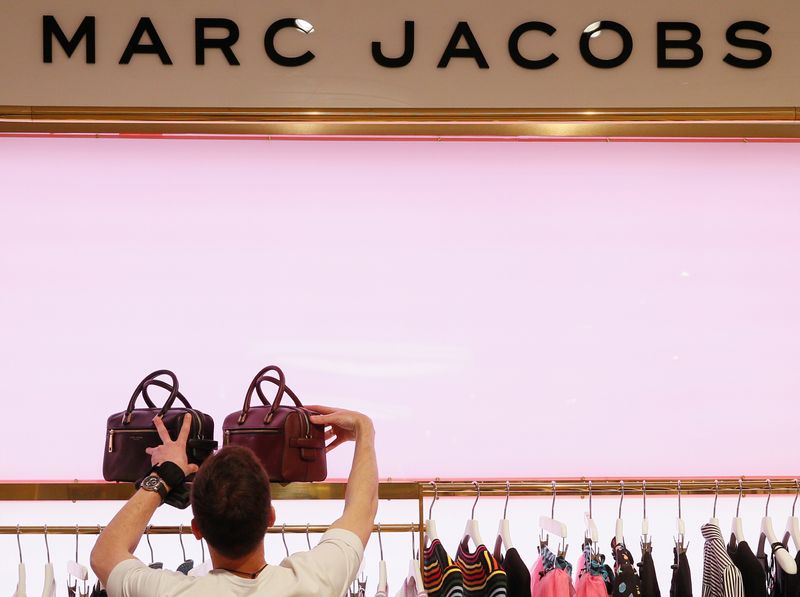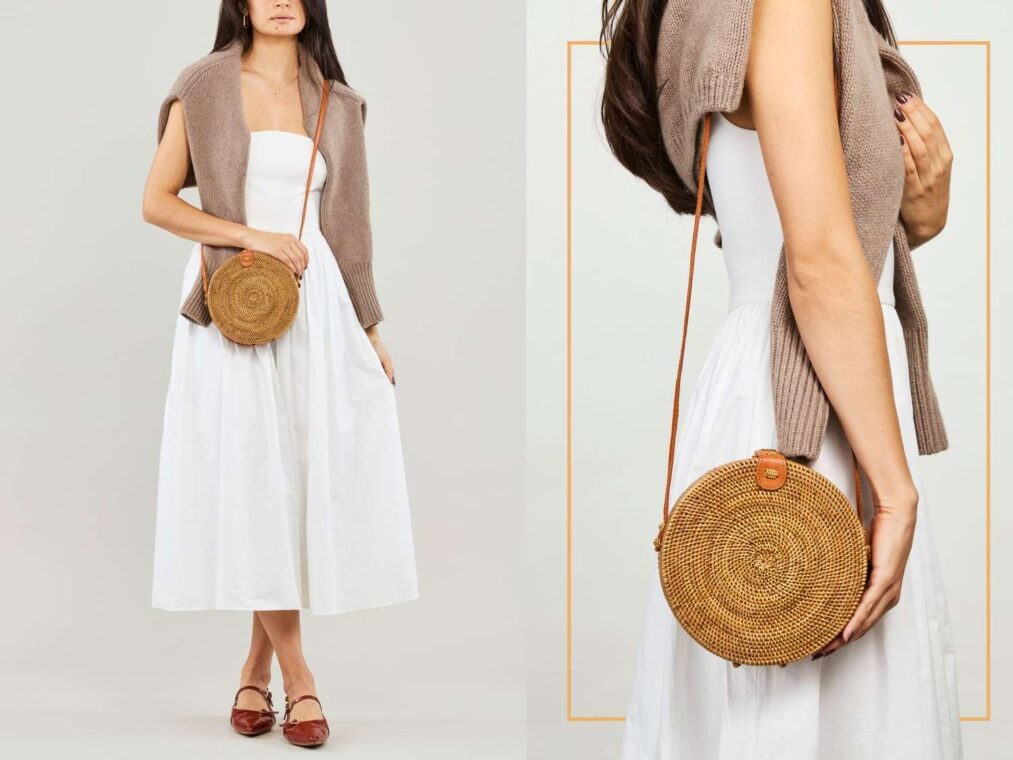Specialty store Outline, situated on Brooklyn’s desirable shopping destination Atlantic Avenue, has built a passionate following off of its highly curated mix of elite and emerging designers. The Row sits in company with Colleen Allen. Dries Van Noten hangs (on perfectly-spaced wooden hangers) with Cecilie Bahnsen. They’re old school about it, too; the in-store experience is prioritized above all. This spring, founders Margaret Austin and Hannah Rieke folded the e-commerce component of their business. In its place, they launched a catalogue—and they’re part of a wave of fashion brands doing the same.
Outline’s Spring 2025 catalogue—Austin and Rieke plan to release them on a biannual basis—comes enveloped in cherry-red paper with “Outline” emblazoned on its front, in lieu of a traditional cover, with a little paper insert for notes. Open it, and you’re invited to journey through the fabulous New York home of a mother and daughter, catching them in intimate moments wearing nothing but an Autumn Sonata bath towel or jetting out the door in an ankle-length trench from The Row.
“We wanted it to be like a peek inside our customer’s life,” says Austin. In one spread styled by Juliana Salazar and photographed by Tess Ayano, the daughter wears an Auralee white T-shirt, a Maison Margiela cardigan, a sequinned Cecilie Bahnsen skirt, and Comme Si socks whilst peeling an apple in the kitchen and chatting with her mom. Her mother laughs, pie dish in hand, in oversized Auralee selvedge denim separates.
On some pages, there are outfits to drool over. On others, no clothing at all. Artful clutter—like glue sticks, a plastic bag full of pencils, and, of course, a $6,810 Camille Beinhorn Blue sapphire and pearl necklace—litters surfaces. From the props to the scrunch of a sock to the typeface, “every detail was very, very, very intentional,” says Rieke, who comes from a photo production background.
What they’re selling, I’m buying—or at least I’m rummaging in my closet to recreate it while I pinch my pennies for an actual purchase. But I think that’s the point. The catalogue functions more as a moodboard than anything. “The ultimate purpose isn’t shopping,” says Austin. “It is much more about the story than anything else.”
The release has definitely cultivated intrigue, even if reciprocal sales can’t be diagrammed exactly. “The first few weeks, all of our regulars were coming in so effusive about how exciting it was,” says Rieke, who was, admittedly, apprehensive about the launch and subsequent discontinuation of e-comm. But their repeat customers flocked to the store wanting to recreate specific looks and learn more about certain brands. ”We were really shocked at how many shopping requests we got. It’s been a really great month in terms of sales.”
They’re not alone in experiencing success via this retro marketing technique. Eyewear brand Moscot releases a catalogue it dubs the “style guide” annually. Jenni Kayne releases its catalog seasonally. Patagonia has one simply called “journal.” One of the most talked-about, and of the largest scale, is J.Crew, which relaunched its now-biannual catalogue in September 2024 after pausing it in 2017.
In its first issue’s pages, bare-faced men and women of all ages frolic on a chilly New England beach clad in barn jackets, slip dresses, and loafers. Demi Moore covers one iteration of the issue in an oversized sweater, jeans, and, you guessed it, loafers. It reads more like a fashion magazine, with its cover story interview and editorialized shopping pages, than your traditional catalogue.
Today, the lines have blurred between magazine, catalogue, branded content, and zine. Alyssa Vingan, writer, editor, and host of The New Garde podcast, doesn’t take issue with this. “As media continues to evolve, brands will likely take more of their editorial storytelling into their own hands,” she says. “I do not think that, moving forward, readers are going to necessarily care that the beautiful and thoughtful content that they see has been underwritten by a brand.”
Strategically, Vingan also admires J.Crew’s alignment with the traditional press cycle, casting celebrities buoyed by the release of something big, like Moore riding the wave of The Substance’s press junket. Brands like Rhode and Skims also do this well, if only digitally. “They’re all really good at what I think magazines are good at: getting people at the right moment.” In laying those editorialized campaigns to paper, the brands evoke “a hint of nostalgia that also feels fresh,” Vingan continues. This makes sense for a brand like J.Crew.
After its founding in 1983 as a mail-order retailer, the now household-name brand built its business on easy-to-wear basics especially fit for the workplace. But its differentiating factor has long been an ultra-desirable aura of casual prep lovingly documented on Instagram accounts like @lostjcrew, which resurfaces spreads from old J.Crew catalogues. The brand’s founder Arthur Cinader made a bit of magic with the catalogue, especially with the help of his daughter, Emily Scott, who wanted to turn it into something more akin to a fashion magazine. The New Yorker’s Hua Hsu wrote, “where traditional catalogues highlighted the product, J. Crew’s emphasized scenes, tableaux, glimpses of leisurely cool.” Throughout the eighties, the team belabored over photo, copy, and layout to ensure the catalogue permeated culture—and it did. The reissued catalogue looks back to its roots; a representative from J.Crew commented that the goal of the catalogue is to examine that heritage through a modern lens.
Rieke, 32, and Austin, 31, grew up amidst the pinnacle of catalogues. They circled their favorite items in the pages of PB teen, Delia’s, Limited Too, L.L. Bean, even Scholastic Book Fair. “It was the lifestyle that they were selling,” Rieke muses, rather than the specific products themselves. Vingan loved Alloy and the Abercrombie & Fitch A&F Quarterlies. “In hindsight, they were probably inappropriate when I was in high school,” she says of the latter, “but in terms of world building, telling a brand story, that was a really interesting way to do it, and I bought into it for sure.”
It’s that buzz word, world-building, that is so important here, but technically, that is something you can do online. Isn’t it? “I think that people enjoy having that object to have on display on their coffee table, to interact with something they already know they like, but in a different way,” Vingan theorizes. “With the ephemerality of an Instagram post—here today, gone tomorrow—there is a hunger for something that feels special.”
It’s the opposite strategy of the mass-distributed catalogues still in print, which most of us move straight from the mailbox to the recycling bin. Unsurprisingly, it parallels a recent rise in niche print magazines as collector’s items despite a general downturn in print sales.
When the first edition of the resurrected J.Crew catalogue came out, Vingan went to the store to secure her own copy. “I understand that it’s niche,” she says. “Not everything has to be made in huge quantities. Not everything has to appeal to everyone.” Neither Outline nor J.Crew sent a catalogue to every single customer. “You probably had to make some sort of effort to get it,” says Vingan, “which I don’t think is a bad thing.”





